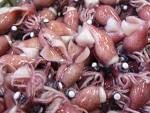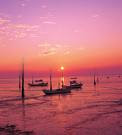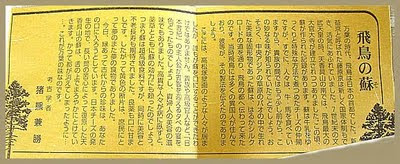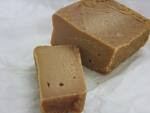::::::::::::::::::::::::::::::::::::::::::::::::::::::::::::::::::::::::::::::::::::::::::::::::::::
Wakayama Prefecture

Wakayama Prefecture (和歌山県, Wakayama-ken) is a prefecture of Japan located on the Kii Peninsula in the Kansai region on Honshū island. The capital is the city of Wakayama.
© More in the WIKIPEDIA !
In october, daidai mikan だいだい 和歌山 are shipped to all of Japan.
. . . CLICK here for Photos !
Koya San in Wakayama 高野山
The ancient Kumano Pilgrims Road
Kumano Kodoo, Kumano Kodō (熊野古道)
Waterfall of Nachi, Nachi no Taki
:::::::::::::::::::::::::::::::::::::::::::::::::::::::::::::::::::::::::::::::::::::::::::::::::::
Regional dishes from Wakayama 和歌山の郷土料理
. . . CLICK here for Photos !
In olden times, many refugees from the capital found a new home in the valleys of Wakayama and brought some of the food culture from the capital (Nara, later Kyoto) with them.
ayuzushi, ayu sushi 鮎ずし sushi with sweetfish
best from the clear waters of the river Kozagawa 古座川
in this river there are also tenagaebi 手長えび、unagi うなぎ、zugani ずがに.
and other ayu dishes
ayu no nikuzushi 鮎の肉ずし、ayu no segohsi 鮎のせごし、ayu no shirago 鮎の白子 roe of the female、ayu no misoni 鮎の味噌煮、ayu no kanroni 鮎の甘露煮、aburiayu あぶり鮎、ayu no zoosui 鮎の雑炊
chagayu 大和の茶がゆ rice gruel cooked with tea
Especially in the mountainous area of Kumano, where each farmhouse has its own small tea plantation for private use. They can not grow much rice and to give the daily portions more volume, the rice was cooked with hoojicha tea until it was soft. It is now eaten for breakfast or dinner together with some side dishes.
The color is a brown-green mix.
gomadoofu, gomadofu, goma tofu ごま豆腐 tofu with sesame paste
Mount Koya is especially famous for this dish. It is very healthy and has a pleasant fragance.
. . . CLICK here for Photos !
hijiki no tsukudani ひじきの佃煮 sweetly simmered hijiki seaweed
From Higashi Murogun 東牟婁. The seaweed is collected in early spring. funori and tengusa are also collected.
hoorakuyaki, hooraku yaki ほうらく焼き simmered in an earthen pot
Fish with white meat of the season is simmered in an earthen pot. Sauce from pickled plums is added.
hooroku 焙烙 / 炮烙 / ホーロク / ほうろく is a special earthen pot
hooraku is a local dialect version.
igami no nitsuke いがみの煮付け boiled igami fish
a typical fish of Soutern Wakayama, igami budai「いがみ(ブダイ)
Leptoscarus japonicus.
Served for the new year, boiled with its head and some potatoes to go with it.
. . . CLICK here for Photos !
Papageifisch
inoko mochi 猪子餅, 亥の子餅 ricecakes like little wild boars
Made for the autumn festival of Wild Boars (inoko matsuri いのこ祭り for the deity of Wild Boars 亥の神様, to see him off to the mountains for his winter rest.
The mochi war white and red anko is pasted around them. There are 12 in a common year and 13 in a leap year (uruudoshi 閏年), placed in a wooden masu as offering to the deity.
Marishiten and the wild boar mochi connection
imomochi, imo mochi いももち sweet potato mochi
mat along the coast of Kumano, where there was not enough space to grow rice. In former times, a little wheat and sweet potatoes was the daily food of the poor farmers, especially along the coast of Higashi Muro 東牟婁海岸. Their other food was
ukecha
ukecha うけ茶, when the dried sweet potaotes were placed in a bowl of green tea.
itadori nimono イタドリ煮物 boiled itadori fern
gathered from the end of march. For keeping it is pickled in salt, shiozuke 塩漬け.
. . . CLICK here for Photos !

jakozushi, jako sushi じゃこ寿司 sushi from small river fish
jako (zako) じゃこ【雑魚】
kawauo 川魚(じゃこ jako in the local dialect) river fish, they were quite common in the waters around Wakayama. They were boiled with sweet soy sauce and then put on sushi rice, eaten in summer and as oshizushi for the autumn festival. Often wrapped in a persimmon leaf, like the
Benkei no jakosushi 弁慶のじゃこすし
from fish of the river Ki no Kawa 紀ノ川 near Koya-san 高野山.
:::::::::::::::::::::::::::::::::::::::::::::::::::::::::::::::::::::::::::::::::::::::::::::::::::::
kaki 柿 persimmon
an important product of Wakayama
kushigaki 串柿 ( くしがき) dried persimmons on a stick
town of Shigo, Katsuragi
kakijamu, kaki jam 柿ジャム persimmon jam
It contains a lot of vitamin C, carotin and calium. Like this it could be eaten the whole year.
kaki no hazushi, kaki no ha sushi 柿の葉ずし sushi wrapped in a persimmon leaf
more famous in Nara 柿の葉 葉寿司
kaki no nukazuke 柿の粕漬け persimmons pickled in rice bran
from the Ito area 伊都地方, were Fuyuugaki 富有柿 were grown. It was a special gift of this area.
kakizuke daikon 柿漬け大根 pickled radish with persimmons
The peel of bitter persimmons was pickled with takuan radish in rice bran. The liquor from the fruit would give it a special fruity flavor.
.................................................................................
kakimaze かきまぜ(o-maze おまぜ) mixed sushi
. . . kashiwa ha no sushi 柏葉のすし sushi in an oak tree leaf
with carrots, goboo, shiitake, fuki no to and bamboo shoots or other seasonal vegetables.
Prepared for memorial services in red color. For happy occasions and festivals yellow omelett stripes and pickled pink ginger were added.
Katsuura and Nachi area 那智勝浦町太田地域
.................................................................................
kamakurazuke kamakura tsuke かまくら漬 / 鎌倉漬 fish sushi
from the Arita area 有田
Especially prepared for visitors, a kind of narezushi, mostly with saba, pickled together with radish, carrots and renkon lotus root, with a lot of salt, sugar and rice vinegar.
:::::::::::::::::::::::::::::::::::::::::::::::::::::::::::::::::::::::::::::::::::::::::::::::::::
Kishuu no umeboshi 紀州の梅干
dried plums from Kishu
Umeboshi 梅干 dried pickled salty plums
from 紀州産 南高 梅
Kishuu ume flavor 紀州梅を使用した梅味の柿の種 snack, kaki no tane
also with peanuts 紀州梅味 柿の種 ピーナッツ入り
. . . CLICK here for Photos !

Kishuu ume konbucha 紀州梅昆布茶 Kombu-Tea with ume flavor
. . . CLICK here for Photos !
Kishuu ume koshu (furuzake) 紀州梅古酒 "old liquor"
. . . CLICK here for Photos !
Kishuu ume monaka 紀州梅と梅最中 / 紀州梅もなか Waffers with ume
. . . CLICK here for Photos !
Kishuu ume negijio raamen 紀州梅ネギ塩ラーメン soup with leek and pickled plums
. . . CLICK here for Photos !
Kishuu ume sofuto 紀州梅ソフト soft icecream
. . . CLICK here for Photos !
Kishuu ume suupu ほんのり紀州梅 スープ春雨 instant soup
with edamame beans and nori
. . . CLICK here for Photos !
Kishuu ume tan / sumi 紀州梅炭 coal from Kishuu plum trees
. . . CLICK here for Photos !
Kishuu ume zerii 紀州梅ゼリー jelly with plums from Kishu
. . . CLICK here for Photos !
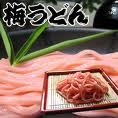
ume udon 梅うどん red udon noodles with ume in the dough
. . . CLICK here for Photos !
also as instant soup from Nisshin Ume Donbei どん兵衛
usujio Kishuu ume うす塩紀州梅 pickled with less salt
tomato ume とまと梅 tomato plum sauce
tomato―ume(とまとうめ)だれ
from Minabe Village, Yutosei 優糖星
:::::::::::::::::::::::::::::::::::::::::::::::::::::::::::::::::::::::::::::::::::::::::::::::::::
kokerazushi, kokera sushi こけらずし layered festival sushi
From Matsue area 松江
For the autumn festival. Made with shrimp and seasoned fish powder (soboro).
kokerazushi 柿鮓 "wood shingled sushi", layered sushi
komugi mochi 小麦餅 wheat flour mochi
11 days after hangeshoo (はんげしょう)半夏生, the summer solstice.
haggeshoomochi 小麦餅(はげっしょう餅 )from Nara
kuenabe, kue nabe クエ鍋 kelp grouper hodgepodge
kue 九絵 Epinephelus moara
This fish loves the warmer sea south of the Kanto area. It grows until about 1 meter long. It lays its eggs in the cliffs around Hidaka coast. In winter, it is eaten in hodgepodge, as sashimi or soaked in ricewine.
from Hidaka 日高町
. . . CLICK here for Photos !
:::::::::::::::::::::::::::::::::::::::::::::::::::::::::::::::::::::::::::::::::::::::::::::::::::
kujira 鯨 whale
Mostly caught in Taiji (太地町, Taiji-chō), located in Higashimuro District.
Taiji Whale Museum opened in 1969.
太地の鯨料理 紀州 Kishu Dishes with whale meat
Wada Kakuemon, later known as Taiji Kakuemon, invented the whaling net technique called Amitori hoo (網取法) to increase the safety and efficiency of whaling. This method lasted more than 200 years.
kujira no goma-ae 鯨のごま和え whale meat with sesame dressing
first prepared by 太地角右衛門 Taji Kakuemon in the Edo period. Also prepared with misoae.
kujira no tazuta age 鯨の竜田揚げ deep-fried whale meat
This was most common in the good old days.
kujira suteeki 鯨ステーキ whale meat steak
sarashikujira no sumiso-ae さらし鯨の酢味噌和え
whale meat with vinegar-miso paste dressing
sarashi kujira さらしくじら【晒し鯨】 The fins and skin are thinly cut, blanched in boiling water to get rid of the skin and then "cooled down" (sarashi) in ice water. This tasts good with a vinegary flavor dressing. It is also eaten in miso soup.
whale meat dishes as KIGO for summer
saezuri 鯨さえずり the tongue of the whale, often as sashimi or bacon
saezuri is a word for the twittering of birds
. . . CLICK here for Photos !
WKD : Whale, kigo for all winter
:::::::::::::::::::::::::::::::::::::::::::::::::::::::::::::::::::::::::::::::::::::::::::::::::::::
kurumimochi, kurumi mochi くるみ餅 mochi with walnuts
Mochi are prepared with the new rice for the autumn festival and offered to the tutelary clan deities (ujigami 氏神様) . Their light green color is pleasant.
. . . CLICK here for Photos !
mamegohan, mame gohan 豆ごはん rice with reeen peas
from Inancho town 印南町, a growing region for endomame えんどう【豌豆】 podded peas.
There are many varieties of these peas like oranda オランダ、usui ウスイ、saya endoo サヤエンドウ. For cooking with rice, the usui-endo are used.
. . . CLICK here for Photos !
menosushi, me no sushi めのすし sushi wrapped in seaweed
Every spring, a specially wide seaweed of the kombu family is harvested near East Muro town 東牟婁 (and in parts of neighbouring Mie prefecture).
antokume あんとくめ, hirome ひろめ are names for this seaweed. It is dried in the sun and can be used all year long for wrapping sushi.
Naraae, Nara ae, Nara-ae 奈良あえ Nara salad
with radish, carrots, abura-age tofu, dried shiitake mushrooms, goboo, and a sauce with sake, sugar, vinegar and salt.
The area of Hirai, Kozagawa 古座川町平井地区
. . . CLICK here for Photos of the area !
This area is famous for the fugitives from the capital Nara, who kept their food culture like in the old days. Their regional specialities have quite a revival these days. For example yuzu products and
ayuzushi and uzumidoofu in our list here.
ni namasu, ninamasu 煮なます boiled "namasu"
finely chopped raw fish and vegetables soaked in vinegar, then boiled
osasuri おさすり (ebitsu えびつ)festival confect
Offering on May 5, for the Boy's festival, together with chimaki dumplings.
They used to be made from wheat flour in green color or with past of soramame beans.
. . . CLICK here for Photos !
:::::::::::::::::::::::::::::::::::::::::::::::::::::::::::::::::::::::::::::::::::::::::::::::::::::
saba no hayazushi to amazake 鯖の早寿しと甘酒
mackerel sushi and sweet ricewine
From Hidaka 日高地方
Prepared for the autumn festival in October, a kind of narezushi (fermented sushi), but nowadays vineger is used.
narezushi is prepared for festivals since more than 800 years. The Arita area 有田 also has a long tradition. They wrap the sushi into a leaf similar to the susuki reed grass, called ase no ha sushi あせの葉寿司.
saba no takikomi gohan 鯖の炊きこみご飯 mackerel cooked with rice
Along the coastline of Wakayama, takikomi rice cooked with ingredients is often prepared. Also sanma pacific saury, oysters or mussles are used. In the mountains, mushrooms and sansai mountain vegetables are cooked with the rice.
saera no teppoo さえらのてっぽう Pacific saury sushi
Along the southern coastline, when autumn turns in winter, sanma Pacific saury comed down from the North and has less fat, just right to prepare sushi.
This is a special dish for festivities., prepared with vinegared sushi rice and hand-kneaded sushi.
saerazushi さえらずし(sanmazushi さんまずし)
sanmazushi, sanma sushi さんまずし 秋刀魚 Pacific saury sushi
sanma comes down from Hokkaido and reaches Wakayama in winter. It has less fat and is right for maruboshi 丸干し, drying in the sun and wind of the beach. The fish is salted over night and then dried for two or three days. Grilled is a delicacy.
For sugatazushi, with head and tail, some juice of daidai mikan is added to the sushi rice.
. . . CLICK here for sugatazushi Photos !
Makrelenhecht. Cololabis saira.
satoimo kukizuke 里芋くき漬け pickles from taro stems
from Higashi Murogun 東牟婁.
The stems are also eaten as boiled vegetables or with dressing.
(see zuiki below)
:::::::::::::::::::::::::::::::::::::::::::::::::::::::::::::::::::::::::::::::::::::::::::::::::::::

tachiuo, tachi-uo たちうお【太刀魚】
hairtail; cutlass fish; scabbard fish
Trichiurus lepturus auriga
Degenfisch
tachi-uo to chiizu no pai tsutsumi 太刀魚とチーズのパイ包み
scabbard fish wrapped in cheese and baked as a pie
tachi-uo sushi, tachiuo sushi タチウオすし sushi from scabbard fish
The best in Japan, as they say.
From Arita town. 有田市 which has the highest catch of this fish.
. . . CLICK here for Photos !
::::::::::::::::::::::::::::::::::::::::::::::::::::::::::::::::::::::::::::::::::::::::::::::::::::
takanazushi, takana sushi 高菜ずし sushi from takana leaves
. . . CLICK here for Photos !
Brassica juncea var. integrifolia.
nubarizushi, nubari sushi めばり寿司 from Mie prefecture
. . . meharizushi, mehari sushi めはりずし large sushi
wrapped inthe pickled leaves of Takana, which are pickled in winter and early spring. They were used to wrap the lunch rice for forest workers.
The names comes from a wordplay, with "opeinig your eyes wide when seeing this huge lunch paket" "me o miharu hodo okii".
Nara no mehari sushi
. Takana 高菜 mustard greens .
toofuyaki 豆腐焼き grilled tofu
For the New Year preparations. A kind of dengaku with miso paste.
In Wakayama spielt der Tofu bei den Neujahrsvorbereitungen eine wichtige Rolle. Nach dem großen Neujahrs-Hausputz am 31. Dezember treffen sich die Mitglieder der „Tofu-Gruppe“ (toofukoo豆腐講) abwechselnd in einem Haus und genießen gegrillten Tofu mit Miso-Paste (toofudengaku), während sie die Ereignisse des abgelaufenen Jahres besprechen und sich an glückverheißenden symbolischen Wortspielen mit MISO (失敗、弱みそ, 泣きみそ) und TOFU erfreuen.
:::::::::::::::::::::::::::::::::::::::::::::::::::::::::::::::::::::::::::::::::::::::::::::::::::::
umebishio, ume hishio 梅びしお paste from pickled plums
umeboshi were made into a fine paste and cooked with sugar. Their sweet-sour taste was a condiment for all food, for salads and fish dishes.
. . . CLICK here for Photos !
ume gohan, umemeshi 梅ごはん pickled umeboshi plums with rice
Best in summer, when people were tired and the sourness of the plums together with the perilla brought back their appetite. It was good cold as a luchbox.
. . . CLICK here for Photos !
utsubo ryoori うつぼ料理 moray (eel) dishes
in Kushimoto, Southern Kishu 南紀串本
it was eaten as a stamina food for the farmers and fishermen. Dried in the cold wind, then prepared as tsukudani. It was given to pregnant women and after birth to make the milk flow for the baby.
It best season is in summer, like hamo eel.
. . . CLICK here for Photos !
. utsubo 靱 moray eel, Kidako eel .
Gymnothorax kidako
. utsubogusa 靱草 (うつぼぐさ) "Kidako eel plant" .
uzumidoofu, uzumi tofu, uzumi dofu うずみ豆腐 "tofu burried in rice"
uzumaru 埋まる lit. means to be burried under something.
It can be freshly cooked white rice or rice gruel (kayu) or mochigome sticky rice.
From the mountainous area around Kozagawa 古座川町, where followers of the Heike lived in secrecy and kept the tradition of the capital Nara.
yorori no zushi ヨロリのずし sushi from black tuna
yorori ヨロリis another name for kuroshibi kamasu クロシビカマス
. . . CLICK here for Photos !
black tuna, Promethichthys prometheus
He looks rather black,has a lot of fat and tasts superb. You can also fry the meat, cook it or use it for other fish dishes.
. WASHOKU
yubamaki ゆば巻 "suhsi rolled in soymilk skin"
zuiki no nimono ずいきの煮物 boiled taro stems
mostly from yatsuhashi 八つ頭 and ebi-imo えび芋 varieties.
zuiki is good for women after giving birth.
芋茎(ずいき) Zuiki Taro and the 随喜 Zuiki Vegetable Festival
:::::::::::::::::::::::::::::::::::::::::::::::::::::::::::::::::::::::::::::::::::::::::::::::::::::
External LINK
Food, Dining, Festivals in Wakayama
*****************************
Worldwide use
*****************************
Things found on the way
*****************************
HAIKU
*****************************
Related words
***** WASHOKU : Regional Japanese Dishes
***** . Folk Toys from Wakayama .
:::::::::::::::::::::::::::::::::::::::::::::::::::::::::::::::::::::::::::::::::::::::::::::::::::





